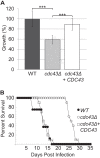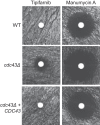Restricted substrate specificity for the geranylgeranyltransferase-I enzyme in Cryptococcus neoformans: implications for virulence
- PMID: 24014765
- PMCID: PMC3837929
- DOI: 10.1128/EC.00193-13
Restricted substrate specificity for the geranylgeranyltransferase-I enzyme in Cryptococcus neoformans: implications for virulence
Abstract
Proper cellular localization is required for the function of many proteins. The CaaX prenyltransferases (where CaaX indicates a cysteine followed by two aliphatic amino acids and a variable amino acid) direct the subcellular localization of a large group of proteins by catalyzing the attachment of hydrophobic isoprenoid moieties onto C-terminal CaaX motifs, thus facilitating membrane association. This group of enzymes includes farnesyltransferase (Ftase) and geranylgeranyltransferase-I (Ggtase-1). Classically, the variable (X) amino acid determines whether a protein will be an Ftase or Ggtase-I substrate, with Ggtase-I substrates often containing CaaL motifs. In this study, we identify the gene encoding the β subunit of Ggtase-I (CDC43) and demonstrate that Ggtase-mediated activity is not essential. However, Cryptococcus neoformans CDC43 is important for thermotolerance, morphogenesis, and virulence. We find that Ggtase-I function is required for full membrane localization of Rho10 and the two Cdc42 paralogs (Cdc42 and Cdc420). Interestingly, the related Rac and Ras proteins are not mislocalized in the cdc43Δ mutant even though they contain similar CaaL motifs. Additionally, the membrane localization of each of these GTPases is dependent on the prenylation of the CaaX cysteine. These results indicate that C. neoformans CaaX prenyltransferases may recognize their substrates in a unique manner from existing models of prenyltransferase specificity. It also suggests that the C. neoformans Ftase, which has been shown to be more important for C. neoformans proliferation and viability, may be the primary prenyltransferase for proteins that are typically geranylgeranylated in other species.
Figures







Similar articles
-
Genetic evidence for in vivo cross-specificity of the CaaX-box protein prenyltransferases farnesyltransferase and geranylgeranyltransferase-I in Saccharomyces cerevisiae.Mol Cell Biol. 1993 Jul;13(7):4260-75. doi: 10.1128/mcb.13.7.4260-4275.1993. Mol Cell Biol. 1993. PMID: 8321228 Free PMC article.
-
Geranylgeranyltransferase I of Candida albicans: null mutants or enzyme inhibitors produce unexpected phenotypes.J Bacteriol. 2000 Feb;182(3):704-13. doi: 10.1128/JB.182.3.704-713.2000. J Bacteriol. 2000. PMID: 10633104 Free PMC article.
-
Amino acid residues that define both the isoprenoid and CAAX preferences of the Saccharomyces cerevisiae protein farnesyltransferase. Creating the perfect farnesyltransferase.J Biol Chem. 1998 Apr 17;273(16):9472-9. doi: 10.1074/jbc.273.16.9472. J Biol Chem. 1998. PMID: 9545274
-
Protein Prenyltransferases and Their Inhibitors: Structural and Functional Characterization.Int J Mol Sci. 2022 May 12;23(10):5424. doi: 10.3390/ijms23105424. Int J Mol Sci. 2022. PMID: 35628237 Free PMC article. Review.
-
Thematic review series: lipid posttranslational modifications. Structural biology of protein farnesyltransferase and geranylgeranyltransferase type I.J Lipid Res. 2006 Apr;47(4):681-99. doi: 10.1194/jlr.R600002-JLR200. Epub 2006 Feb 13. J Lipid Res. 2006. PMID: 16477080 Review.
Cited by
-
Differential requirements of protein geranylgeranylation for the virulence of human pathogenic fungi.Virulence. 2019 Dec;10(1):511-526. doi: 10.1080/21505594.2019.1620063. Virulence. 2019. PMID: 31131706 Free PMC article.
-
Roles for Stress Response and Cell Wall Biosynthesis Pathways in Caspofungin Tolerance in Cryptococcus neoformans.Genetics. 2019 Sep;213(1):213-227. doi: 10.1534/genetics.119.302290. Epub 2019 Jul 2. Genetics. 2019. PMID: 31266771 Free PMC article.
-
Relative Contributions of Prenylation and Postprenylation Processing in Cryptococcus neoformans Pathogenesis.mSphere. 2016 Mar 30;1(2):e00084-15. doi: 10.1128/mSphere.00084-15. eCollection 2016 Mar-Apr. mSphere. 2016. PMID: 27303728 Free PMC article.
-
Efficient farnesylation of an extended C-terminal C(x)3X sequence motif expands the scope of the prenylated proteome.J Biol Chem. 2018 Feb 23;293(8):2770-2785. doi: 10.1074/jbc.M117.805770. Epub 2017 Dec 27. J Biol Chem. 2018. PMID: 29282289 Free PMC article.
-
T cell infiltration into the brain triggers pulmonary dysfunction in murine Cryptococcus-associated IRIS.Nat Commun. 2023 Jun 28;14(1):3831. doi: 10.1038/s41467-023-39518-x. Nat Commun. 2023. PMID: 37380639 Free PMC article.
References
-
- Nguyen UT, Goody RS, Alexandrov K. 2010. Understanding and exploiting protein prenyltransferases. Chembiochem 11:1194–1201 - PubMed
-
- Basso AD, Kirschmeier P, Bishop WR. 2006. Lipid posttranslational modifications. Farnesyl transferase inhibitors. J. Lipid Res. 47:15–31 - PubMed
-
- Casey PJ, Seabra MC. 1996. Protein prenyltransferases. J. Biol. Chem. 271:5289–5292 - PubMed
-
- Reid TS, Terry KL, Casey PJ, Beese LS. 2004. Crystallographic analysis of CaaX prenyltransferases complexed with substrates defines rules of protein substrate selectivity. J. Mol. Biol. 343:417–433 - PubMed
-
- Moores SL, Schaber MD, Mosser SD, Rands E, O'Hara MB, Garsky VM, Marshall MS, Pompliano DL, Gibbs JB. 1991. Sequence dependence of protein isoprenylation. J. Biol. Chem. 266:14603–14610 - PubMed
Publication types
MeSH terms
Substances
Grants and funding
LinkOut - more resources
Full Text Sources
Other Literature Sources
Miscellaneous

